Metrocon Convention
EXOBIOLOGY FIRST HOUR part a
Linton Herbert room 21
Tampa Convention Center, Tampa Florida
Sunday, June 19, 20011 3 PM
Where are the aliens?
For many years people have thought that with so many stars out there there ought to be planets with life on them, some of which should be intelligent forms that might have gotten in touch with us. Recent research does indeed show a lot of planets but so far we have received neither messages nor visitors, at least none that are beyond challenge. There are a number of reasons that have been suggested including absence of truly suitable planets, very rare frequency of life forming, very rare frequency of appearance of intelligence and, most worrying, very brief period of advanced technology before a society collapses. This is what we will look at.
The word “evolve” means “turn out.” So don’t look for evolution to be thrown out as a theory any time soon. It just means the way things turn out. That definition is so broad that it is hardly a theory at all. Our current understanding is more specific. Living things have inheritable variation, and some of this variation produces differential survival and reproduction. So it is logical to expect any line of animals to change slowly but steadily under the pressure of selection. Most of the time this is natural selection meaning that it does not involve humans deliberately breeding animals.
Somewhat more difficult is the concept of speciation. If you take a population of animals and separate it into two populations that you keep apart long enough, they will evolve to the point where they cannot mate and have fertile offspring. This is called “allopatric speciation” distinguishing it from “sympatric speciation” whereby two species develop even though the populations were never separated.
If you think about it, you must recognize that if evolution is good, then speciation must be good. Suppose you want to have an animal evolve that eats earthworms. You might go the robin route or the mole route. But you won’t have much luck with something that is half way between a mole and a robin; it will be outcompeted by real moles and real robins. In fact when a new niche opens up in an environment that no animal is optimized for, there will be a race in evolution, and the animal form that can speciate faster has an advantage in putting out a suitable form first. So there must be a premium on fast speciation. And this will be true anywhere there is life, this planet or elsewhere.
But rapid speciation has a problem. Let’s say it takes 2,000 generations of separation for speciation to occur.
We will assume chromosomes are found everywhere there is life.
Now consider a valley with 1,000 animals, say mice. On mouse has a particular normal chromosome. 
It replicates,
 and the two copies wind up in two offspring of the original mouse. One mouse scurries across the valley, and while it is there the climate undergoes an abrupt change. A glacier splits the valley in two. The glacier remains for two thousand mouse generations and then melts. The F2,000 mouse from the far side of the valley returns and mates with an F2,000 mouse from the near side. But they cannot have normal fertile offspring. They have undergone speciation in that time. Now, instead of a glacier, the mice mate at random throughout the valley, the population being constant at 1,000. Since there are 2,000 copies of the chromosome it takes on average 2,000 generations before F2,000 mates with F2,000. The offspring are not fertile. Since this is true of every chromosome in every mouse, the population dies.
and the two copies wind up in two offspring of the original mouse. One mouse scurries across the valley, and while it is there the climate undergoes an abrupt change. A glacier splits the valley in two. The glacier remains for two thousand mouse generations and then melts. The F2,000 mouse from the far side of the valley returns and mates with an F2,000 mouse from the near side. But they cannot have normal fertile offspring. They have undergone speciation in that time. Now, instead of a glacier, the mice mate at random throughout the valley, the population being constant at 1,000. Since there are 2,000 copies of the chromosome it takes on average 2,000 generations before F2,000 mates with F2,000. The offspring are not fertile. Since this is true of every chromosome in every mouse, the population dies.
 . . . F1 . . . . . ............... . . . . .
. . . F1 . . . . . ............... . . . . .  F1 .................................................
F1 ................................................. F1...............................................
F1............................................... F1
F1
........
 . .
. . 

 ...................................
................................... ........................................
........................................ .........................................
.........................................
F2,000 .................................. F2,000 ......................................... F2,000 ..................................... F2,000
The chromosomes never even knew the glacier was there. They just don’t recognize each other. Obviously this is an event that evolution will not tolerate, so a preventive mechanism supervenes. This mechanism keeps population sizes low enough for safety by limiting fertility of larger populations. It appears that if things get too out of hand the population is simply wiped out long before speciation effects set in.
Speciation probably occurs by slow degrees, although opinions do vary. There is a ring of seagulls around the arctic circle. If you start a Labrador and look at the local gulls, they are able to inbreed with gulls just to their west, which are in turn able to interbreed with gulls to their own was and so forth until you wind up in Scotland. But if you try to cross Scottish gulls with Labrador gulls, they cannot have fertile offspring. They have evolved gradually into two species. So saying 2,000 generations to speciation is just an approximation.
Granted that, how plausible is our number? When Columbus got to the Canary Islands, there were no mice there. Since then mice have spread throughout the islands, occupying narrow steep valleys. Shepherds on the ridges can see each other across the valleys and have developed a whistled dialect of Spanish that lets them chat; it’s an unusually long distance for a conversation, but it can be done. The mice in each valley have different arrangements of chromosomes, meaning that they would not be able to have fertile offspring. So speciation has occurred in about 500 years. Or 6,000 months. It takes a mouse at least a month to mature. If you recon that a wild mouse lives a very few months, a 2 month average generation time seams reasonable, so that would be 3,000 generations to the present. The chromosomal change is a late change. Obviously those seagulls have not developed that. So this is consitent with out 2,000 generations to speciation guess. The same logic holds for rabbits in the Azores. And if camels were domesticated a 7,000 years ago and soon some were taken to Africa, and assuming a couple or three years generation time for camels, then African dromedary camels and Asian Bactrian camels have been separated for over 2,000 generations, and sure enough they are different species.
So it appears that 2,000 years or so to speciation is plausible and in fact is more or less standard.
So evolution has arranged to keep an animal population below 1,000 or else. It does this by reducing fertility if the animals are not closely enough kin.
The mechanism can be seen at work simply by looking at animals in the field and comparing population size with growth rate as a surrogate for fertility. More than 1,000 such studies have been collected and this is what they found:
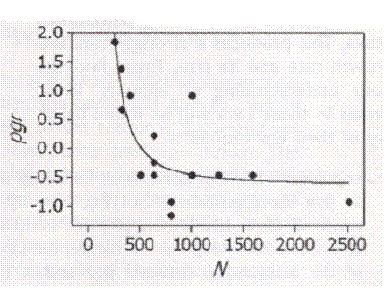
On the Regulation of Populations of Mammals,
Birds, Fish, and Insects, Richard M. Sibly et al.
SCIENCE vol. 309 no. 5734 July 22, 2005
page 607 – 610
The vertical axis is the growth rate. The horizontal
Axis is the estimated population size. The did not
find inbreeding depression but we know it is real.
Less kin, less fertile. And notice that by the time the population reaches 1,000 fertility has fallen blow survivable.
This has been shown in humans. A study in Denmark compares family size with the distance apart the parents were born.
EXPERIENCE FROM THE DENMARK STUDY
A study in Denmark compared fertility with the distance between birthplaces of couples. Because they were looking at distance not area, the curve is distorted, but it is the same curve.
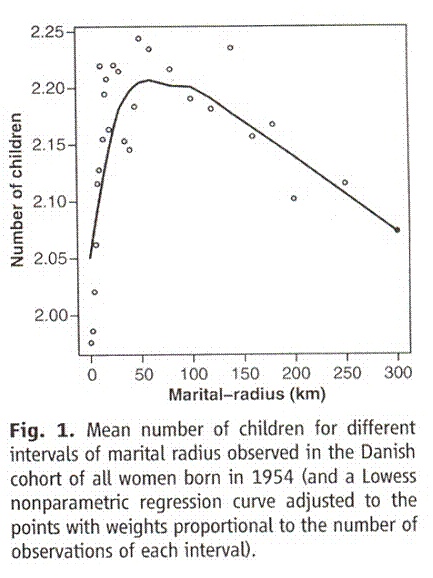
Graph taken from Comment on “An Association Between the Kinship and Fertility of Human Couples,” Rodrigo Labouriau and António Amorim SCIENCE vol. 322, page 1634b December 12, 2008Vertical axis is number of grandchildren. Horizontal axis is distance in kilometers between the birth places of the parents.
They have an enormous genealogy in Iceland covering the whole country for a thousand years. Drawing on that, they took a cohort of couples and calculated their kinship by counting ancestors they shared ten generations back. Then they compared that with the number of children the couples had.
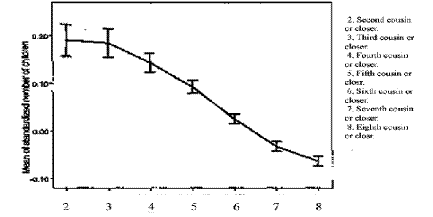
Graph is from An Association between Kinship and Fertility in Human Couples, Agnar Helgason, Snaebjoern Palsson, Daniel Abjardson, Pordur Kristjansson and Karl Stefanson, SCIENCE vol. 319 February 8, 2008 page 813.
Notice that by the time the kinship is a distant as 7th cousins, fertility is too low for survival.
You could look at this graph for a long time. It is a challenge to what most people think is a proper mating stragegy. Let’s think about mating strategies.
The default will be anybody can marry anybody. 7 billion people in the world gives you 7 billion choices. I don’t think anybody would approve of that one, but I might be wrong.
Next let us exclude children and couples separated by 50 years. Maybe that brings your choices down to 5 billion.
Now let’s exclude people of the same sex. I am not saying that I insist on that, I am just listing mating strategies. Now we are down to 2.5 billion.
Now let’s think about racists. They divide the world by races which they think ought not intermarry. The name of the field is “eugenics,” and it also excludes a bunch of other choices. The field is complex and not much respected. Anyway, we are now down to 500 million.
Now think about national socialism or Nazi-ism. Everyone in the country can marry anybody else. There is a “national society.” The historical Nazi’s may have been utterly evil, but national socialism is not dead. In fact it is the law of the land. The Supreme Court ruled “Separate but equal is unconstitutional.” Since then we have been a national society as limited by age and sometimes sex. At 300 million the United States is a giant. A more typical country might be 50 million. Let’s say age bans take that down to 40 million and sex bands take that down to 20 million.
Then there is religion. There might be 10 in your country, so your horizon if you want to stay with your own religion is now about 2 million and other social restrictions might take you down to 1 million.
I think it would be fair to say that most people would feel comfortable somewhere along that scale. But there is a serious problem we now see in the long run every single one is suicide. And there is a question here. Will the population simply decline and stabilize or will it go extinct?
Here is a computer simulation of a population that limits its fertility according to degree of kinship.
Parameters for each point are:
10 simulations averaged.
Populations followed to extinction or to 1,000 generations.
Maximum of 6 offspring per couple.
Initial population 100.
Maximum population, tracked on the x axis, limited by eliminating offspring at random as necessary. (Number of offspring per individual in the maximum population in the final generation [minus one to replace that individual] tracked on the y axis.)
100 gene pairs subject to recessive lethal mutations.
10 mutations per site per 100,000 generations.
100 gene pairs subject to detuning mutations. (In fact it amounts to 200 per chromosome.)
400 mutations per site per 100,000 generations.
40 one thousandths of one offspring lost at meiosis per unit of detuning.
No populations were added from saved files.

It is not as elegant as the real world data, but you can see that the curve is much the same. Then the same program was run with the same parameters except that the population was permitted to rise to 20,000, about all that C++ language can handle.

Offspring on the vertical axis; generations along the horizontal. Because of the limits of how many things the computer can keep track of, the curve is truncated.
The population cycled twice before dying out.
So how does this play out in real life? There is a place called Longhouse Valley in the Southwest. It was occupied by Anasazi for a few centuries. They did some excavations and found every hearth that was ever used and by doing carbon 14 dating on the charcoal they could tell what years each house had been occupied. This gave them an annual census of the valley, which they then compared with tree ring width.

Jared M. Diamond, “Life with the Artificial Anasazi,” NATURE, vol. 419 no. 6907, October 10, 2002 p 567.
As you can see, the two curves match well. So either the Indians are starving all the time and food production limits population or they are cultivating the trees. Since there are obvious vertical lines going up, these people move in groups. You could not get such high annual rise by natural increase. And if people are moving in when the population is greater than the food supply, they are moving in only to starve. So they must be cultivating the trees. In the final plunge, there is no step-wise decrease, so we can rule out emigration, epidemics, famine and war. The decline can only by natural decrease, and as you see they died out to the last family. Their numbers only rose above 1,000 very briefly.
Here is the history of Japanese dynasties with their ages on the horizontal axis and their chance of making it for another 50 years on the vertical. This is not the population of the royal family, just their accomplishment in staying in power. One can assume that a small royal family is less able to control things than a large one.
THE JAPANESE EPERIENCE

Information taken from John B. Teeple TIMELINES OF WORD HISTORY, DK Publishing, New York, NY, 2006, page 554, 555 Japanese dynasties. The vertical axis is the chance that a dynasty of that age will survive another 50 years. The horizontal axis is the age of the dynasties.
The time course and the notch are what we have seen already.
Here is the same thing for China:
THE CHINESE EXPERIENCE

Information taken from John B. Teeple TIMELINES OF WORD HISTORY, DK Publishing, New York, NY, 2006, page 554, 555 Chinese dynasties. The vertical axis is the chance that a dynasty of that age will survive another 50 years. The horizontal axis is the age of the dynasties.
Time course and notch are essentially identical.
Here is the experience of Mesopotamian empires graphed out the same way.
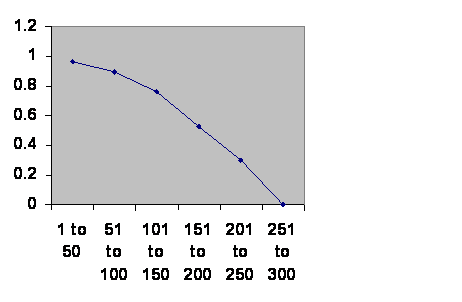
Information taken from R. H. Carling THE WORLD HISTORY CHART International Timeline Inc. Vienna, VA 1985. The experience of Southern Mesopotamia. The vertical axis is The chance of an empire of any age continuing to rule locally for another 50 years. The horizontal axis is the ages of the empires. I broke the Ottoman Empire into two, because their Janissary elite came from two different sources during the early and late empire.
This adds Chaco Canyon to Rome and to the Classical Mayans.
THE MAYAN, ROMAN AND CHACO CANYON EXPERIENCE
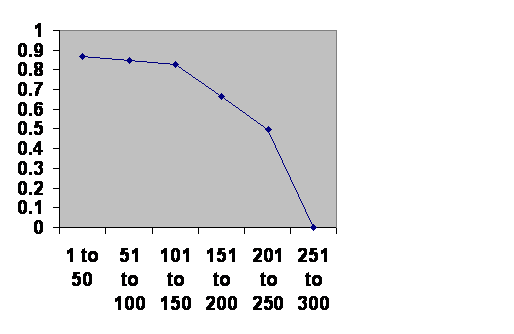 The Romans, the Mayans and the Chaco Canyon Anasazi Indians all established vigorous civilizations that underwent cycles, but none went through enough cycles to be statistically interesting. Here is what happens when you pool them.
The Romans, the Mayans and the Chaco Canyon Anasazi Indians all established vigorous civilizations that underwent cycles, but none went through enough cycles to be statistically interesting. Here is what happens when you pool them.
Information taken from BBC and The Collapse of Complex Societies. Joseph A. Tainter. Cambridge University Press. Cambridge. Eighteenth printing, 2009. The age of each regime when it fell is on the horizontal axis in 50 year increments. The vertical axis is its chance of surviving that half century after it has entered that half century. If the viability of a regime had nothing to do with how long it was since it was founded, the line would be horizontal. If regimes get better at surviving as they are, the line would rise.
So the moral is that yes, this thing can bring down civilizations. Since there is a 300 year brick wall for any large social pool, technology can only progress that long. Our own has had a few lucky breaks, which is the only reason we have advanced farther than the ancient world. But we are on the way out ourselves.
For big numbers, here is a graph of everybody born in the last fifty years. This is for all the jelly beans. UN numbers:

Putting together the different parts of the world we can see the birthrate falling according to a single pattern. Again the curve skews left and tends to saturate. From the appearance here we should be able to expect a soft landing. The population everywhere should decline gently and at some time in the future we can start marrying cousins again and have whatever birth rate we like. The problem is that for the past thirty years the developed world has been below replacement. Siblings are rare and first cousins are becoming rare. A few more generations like that and the kin couples that could be fertile will not exist in significant numbers.
We may have already had our notch. The Great Depression was not only a time of poor incomes. It was a time of low birth rate. Assuming that the notch is in the middle of the cycle, and assuming that the Anaszi could not survive if there was nobody under fifty to do the hardest work, then our population should reach that point fifty years after the last child is born, which should be about 100 years after the 1930’s, in other words in the 2030’s.
Although birth rates have pretty much stabilized below replacement in the developed world, age of first marriage is rising so fast that the last woman who will get married before she is forty, and that pretty much means the last who will have a child, is now about 15. 25 more years of babies left. The time range is about the same.
On top of that, a recent government study showed that the number of people 18 to 24 has risen from 11% to 16% in the past five years. If gay sex is following the same pattern as no sex, then the total who are not having, and probably never will have, straight sex is no 30% and rising at 2% per year. By that reckoning the last young people to have sex will do so in about 30 years. So there are multiple lines of evidence giving about the same story.
All of this is based on first principles. It applies to any intelligent civilization. Of course once people understand it, time permitting, it is an easy fix. But the topic is so obscure that it does not look like anything is going to get done about it. In 15 years I have not got anybody to take a serious interest.
Either there is something wrong with me or something about the topic. Unfortunately I may not be the first to have seen it.
Here are the Ten Commandments.

It’s supposed to be a covenant. Well it sounds like a covenant. Verse 2 identifies the parties to the contract and when and where it was offered. This is an interpretation as I said, that I do not accept. Don’t give up whatever you do or don’t believe about this on my account. But let’s just look at it asking, “Could this be a warning against having a gene pool that is too big?”
Verse 3 gets right down to business. No other gods. Since marriages have, until recently, been held in religious sites, it implies don’t marry outside the group. Verse 4 and half of 5 are making sure. They repeat so there is no misunderstanding. The second half of 5 is somewhat troubling. We know it’s wrong to take revenge on grandchildren. We’ve known that ever since we ate from the Tree of the Knowledge of Good and Evil. But notice that the arithmetic is right. Third and fourth generation – that’s what the UN numbers show. That means this is not a threat, it is a warning.
Verse 6 has a number also – thousands. Not tens of thousands.
If there were 100,000 in the crowd and 12 tribes, that’s about 8,000 per tribe. At say 14 per family, that’s something under 600 families. Look back at the computer simulations. Extinctions are on the right. Extinction rates start high, fall into a kind of happy valley, where there are always children to laugh and play, and then rise again. That is just at the edge of the valley. 8,000 works. You might be able to sustain a population that big. But it is pushing the limit. That is what one would expect from the context.
Verse 7 is another repeat. It would seem we are supposed to take this seriously.
Verses 8 through 11 seem out of place. “Take the weekend off.” That’s no commandment. That is a blessing. Christmas every week. (Or for any pagans out there, Saturnalia every week.)
Verse 12 looks like a threat again. “Honor your parents or I shall kill you.” And the “that” or “so that” is in the Hebrew. I checked an interlinear translation. But it is a single word. Elsewhere, often “so that” is represented by a change in the verb form. In other words “so that” is a more modern way of saying the same thing. The “so that” word occurs most frequently in Deuteronomy, rarely earlier and almost vanishes afterward. In other words, it looks like an anachronism introduced by the Deuteronomist. We even know his name. He was Baruch ben Neriah. (Ben Neriah is a patronymic, effectively a last name. Generally people in scripture don’t get last names. This was a man of no small ego.) Drop the single word meaning “so that” that Baruch introduced, and you get. “You will make your parents proud.” “You will live a long time.” Two more blessings. And there is another line of evidence. In the book of Deuteronomy, they “found” an “old” copy of the law while renovating the Temple. They brought the “discovery” to the king and found that it wasn’t exactly the same as the “newer” versions. So they made a big deal of it and “restored the old version.” Well it sounds like a setup to me. Believe as you will. We are just looking at this to see if it is possible that there was a warning.
So it looks like we are in the second half of the contract. The first half is simple. “No other gods.” In return we are being offered blessings. And besides, the repeats have stopped. Verses 13 through 17 also are blessings. Anyone knows they are social dead ends if you violate them. An American soldier in Vietnam who shot a Viet Cong was more likely to die of the emotional burden after returning home than he was to be killed by another Viet Cong at the time. Having to kill somebody is a curse.
If you add up the blessings you can sum them up as, “And I shall make you decent human beings.” That is the ultimate bribe. Take away a man’s wealth and he will try to rebuild. Take away his loved ones and he will grieve until he can reach out to people again. Take away his health and he will try to recover. Take away his self esteem and he will try to kill himself. Nothing is more precious to us than believing we are worthy.
So it really looks like a covenant. “Limit your gene pool size, and you’ll have babies and things will work out for you; you will be good people.” It is called the Ten Commandments. It is as if we were offered another chance at the Tree of Life and instead we said, “No, I’d rather take another munch out of the fruit of the tree of the Knowledge of Good and Evil.”
But I am beginning to sound like I am preaching and Sunday isn’t for another week yet.
Let’s look at some more mainstream exobiology.
People hang out around water. We may have at one point evolved in water. Most mammals with little body hair are aquatic. We have two airways and six ways to stop them compared with a porpoise which has one of each. We have big flat feet, and Lucy had proportionately even bigger feet. Anyone who has used swim flippers knows how helpful they are. We have a diving reflex that lowers our metabolism under water. Children have been pulled out from under ice after hours and recovered. Babies can be taught how to bob and breathe. Women have long hair, possibly for babies to hold onto in water.
The first person who looked across water and saw land in the distance could have noticed that the bottom of the land was not visible, so the earth is curved. It is round. If that person later traveled to that land and noticed how far it was and how much of the land had been obscured, that person had some inkling of just how big the earth was. A formal measurement, using the height of the sun at the summer solstice in two different locations, was made by Eratosthenes. (276 BC– 195 BC)
 When Copernicus, 1473 – 1543, (the portraits are all from Wikipedia) decided the earth was going around the sun, and the other planets were as well, there was a pressing question. What were the stars? Were they other suns with their own planets and life? There were two responses.
When Copernicus, 1473 – 1543, (the portraits are all from Wikipedia) decided the earth was going around the sun, and the other planets were as well, there was a pressing question. What were the stars? Were they other suns with their own planets and life? There were two responses.
One was by Giordano Bruno, 1548 – 1600, who was one of the last great sorcerers.
His opinion was that of course the stars were suns with their own planets and their own intelligent life. He got burned at the stake. (Best biography is said to be Giordano Bruno, Frances A. Yates, University of Chicago Press, 1964.)
The other approach was that of Tycho Ottensee Brahe, 1546 – 1602, who decided to put the matter to the test. He did meticulous measurements of the positions of stars with a long iron rod. (He didn’t have a telescope.)
He reasoned that if the stars were suns scattered in space that over the course of the year the nearer ones should shift back and forth against the more distant ones, a technique we now call astrometry. “The Twinkle twinkle, little star,” rhyme used to continue, “How I wonder where you are.” It was referring to astrometry. The technique is considered valid today. But Brahe found no shift, no parallax, with his method. He calculated how far away the stars would have to be for there to be parallax he could not detect and came up with a distance so absurdly great that he dismissed it and announced that the stars were fixed in a crystalline sphere, just as many of the ancients had taught.
Although he is now thought to be wrong, he did become the first scientist in that he used meticulous observation and drew his conclusions on the basis of evidence. He was rich and famous for his work. It beats getting burned at the stake. There are those who say that he had a silver nose. His own nose had been cut off in a duel over which of the two duelists was smarter.
He also measured the positions of the planets, and one of his students, Johannes Kepler, 1571 – 1530. took Brahe’s
Johannes Kepler |

|
measurements and calculated that the planets did not go around the sun in circles as Copernicus had suggested, but traveled in ellipses at a speed such that the area swept out by the planet between itself and the sun was constant over time. Later Isaac Newton, 1643 – 1727,
calculated that the movement of the planets was not geometry but was due to a force he called gravity. Newton, according to some, was the last and greatest of sorcerers, and he got to be really rich. He spent a lot of time looking at ancient history, some of the material we have already looked at from Mesopotamia, and decided that the world would end around the middle of this century. He dated it from the crowning of Charlemagne, 768 – 814,
who he thought was the anti-Christ, or maybe the pope was the anti-Christ. Actually he made more than one prediction, but this one coincides as close as you can call it with the fall of Western civilization calculated from the infertility data we have already looked at. One of the prime driving forces of this, of course, is an effective market system based on an honest currency. Newton became the director of the British mint and basically produced the first honest currency since Croesus, 595 -547 BC.

So in a way Newton created the very fate that he had predicted. Of course he thought that the end of the reign of the anti-Chist was a Good Thing, so he would have brought it on if he could have.
Then Albert Einstein, 1879 – 1955,
Albert Einstein |

|
decided that gravity was a myth and it was all geometry after all.
But ever since Kepler, most people have believed that the earth was round, we were living on the outside of it, the earth traveled around the sun, and the stars were suns very far away. So the question has hung over us ever since. Is there life out there? (To be continued on another web page.)
There have been 16,085 visitors so far.
Part b
Part c
Home page.


 and the two copies wind up in two offspring of the original mouse. One mouse scurries across the valley, and while it is there the climate undergoes an abrupt change. A glacier splits the valley in two. The glacier remains for two thousand mouse generations and then melts. The F2,000 mouse from the far side of the valley returns and mates with an F2,000 mouse from the near side. But they cannot have normal fertile offspring. They have undergone speciation in that time. Now, instead of a glacier, the mice mate at random throughout the valley, the population being constant at 1,000. Since there are 2,000 copies of the chromosome it takes on average 2,000 generations before F2,000 mates with F2,000. The offspring are not fertile. Since this is true of every chromosome in every mouse, the population dies.
and the two copies wind up in two offspring of the original mouse. One mouse scurries across the valley, and while it is there the climate undergoes an abrupt change. A glacier splits the valley in two. The glacier remains for two thousand mouse generations and then melts. The F2,000 mouse from the far side of the valley returns and mates with an F2,000 mouse from the near side. But they cannot have normal fertile offspring. They have undergone speciation in that time. Now, instead of a glacier, the mice mate at random throughout the valley, the population being constant at 1,000. Since there are 2,000 copies of the chromosome it takes on average 2,000 generations before F2,000 mates with F2,000. The offspring are not fertile. Since this is true of every chromosome in every mouse, the population dies.  . . . F1 . . . . . ............... . . . . .
. . . F1 . . . . . ............... . . . . .  F1 .................................................
F1 ................................................. F1...............................................
F1............................................... F1
F1
 ...................................
................................... ........................................
........................................ .........................................
.........................................









 The Romans, the Mayans and the Chaco Canyon Anasazi Indians all established vigorous civilizations that underwent cycles, but none went through enough cycles to be statistically interesting. Here is what happens when you pool them.
The Romans, the Mayans and the Chaco Canyon Anasazi Indians all established vigorous civilizations that underwent cycles, but none went through enough cycles to be statistically interesting. Here is what happens when you pool them.








